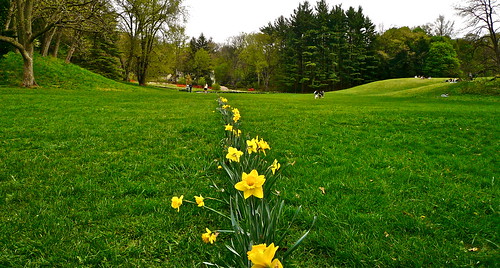Getting space in to the spine is a slow dialectic. Hips-heart-hips-heart-hips. And so on. Chakras bandasana are constructed, not born.
I’d have to tell so many lies to construct a narrative of how the spine has changed. I don’t even remember the subjectivity inside the early body, although it’s true that in the beginning my form was injured, unconscious and weak. The first shift I remember was in the frontal hips, walking across UCLA campus in slow, exaggerated strides to scratch the stretch-itch. A year after that, an intercostal snapped and the chest re-arranged.
At first, I worked the Yogaworks instructions: ground down, stabilize the pelvis… free your hips and the rest will follow. (Traditional mysore practice works the heart: get the ankles, and the feet will follow.)
In any case, for me the foci of backbending awaress continuously oscillates between hips and heart. Usually every few months, I’ll be rebounded from one to the other. And yet… it’s not like chakra b is happening without full engament of both. The grounding and the opening. It just doesn't work unless both ends of the thorax can be open and strong at the some time. There's not just one key.
Root and rise. Will and surrender. Immanence and transcendence. Discipline and freedom. Masculine and feminine. Pffffft. Sometimes the separations feel so… 1950. Pre-postmodern. Pre effing cambrian. Booooring. Can’t we get some original material here? This project of construct our identites and the meaning in the world… it's getting old!
It’s all kind of the same original dualism, isn’t it? Doesn’t the sense of polarity grow from the primal experience of having a body? We have discipline vrs. freedom, and centeries later science vrs. art, because the muscle fibers of the first humans had hard vrs. soft, contract vrs. release. Does that make sense? We have burdened Shiva and Shakti with the heavy mulch of every imaginable binary, splitting ourselves with the same spade.
I am beginning to suspect that there are ways to use the body—the original problem—to resolve primal separations gone awry. (Sociologists, who don't really have bodies, do NOT buy this. This is why I like to teach them yoga.)
I see that, at times, the old polarities coalesce. There emerge new, unstable little atoms of practice. Opposing camps. Competing schools. Whatever dinner party or part of the world I'm in, the two sides always feel the same. At their best, it is the mystics versus the masters.
At one pole, the mystics. Yoga is an art—the art of union in the here and now. The mode of union is surrender. Shakti is transformative: you are always already perfect. This pole is strong on ecstacy—no need to deposit all the consciousness in an earthy, deathly body when satori is eternal and now. Beauty reigns.
At the other pole, the masters. Yoga is a science—the science of purification for transcendence. There is a method for directing the fire—practice smarter, not harder. Willfully discipline the free-ranging play of the ego. This is Shiva is hanging out in the life-pulsing, embodied chakras, driving a strong machine. Integrity is key.
Do you hate one of these camps? What happens when you split one pole outside of yourself, attribute it to the Other? Aren’t you bored yet? Aren’t you interested in the “opposite sex”?
The way each person relates to the tradition—it is so personal. The intimacy of listening to someone’s critique of the other guys… it’s like palm reading, there’s so much karma packed in each small line. When someone spits out scorn for rules or rulelessness… there is sometimes a clamor of hurt child beneath the words. What is that feeling? Is it fear? Which parent is the offender?
So here I am, teaching the new old school. Following a script. Using this historical accident that is vinyasa—a mysticism inside a gymnastics inside a mysticism. An English breathcount, enveloped by Sanskrit vinyasas, and within them a steady inhale, exhale, inhale. I thought I didn't even know the count, but then on Tuesday I said it aloud as a practiced, and both the Sanskrit structure and the English cadence are embedded with the postures as I take them. Does the Pledge of Allegiance come up when you put your hand over your heart? Or some Our Mary when you cross yourself? It's like that.
There's a hypnotic pathway from practice to the place in my subconscious where correct vinyasa is stored, but for now I can only find it by putting my body through an exact sequence of shapes. Wouldn't get me out of the Temple of Doom, but it'll get me in touch with the living ashtanga seed-bed when I need it.
Anyway, is this mysticism or mastery, art or science? Only a fundamentalist scientist would do the traditional scipt… anyone else would be open to creativity (says the mystic).
No! (Says the Master.) Only a flakey mystic would do the traditional script—sacralizing their ritual object and using it to lose themselves in the cadence.
I don’t know. I’ve run my body through that rosary a thousand times and more. It’s working on me from both sides—the ecastasy of love and the roots in the world. It’s slowly making me bored with the duality as it emerges over and over again, holographically, throughout the field of this global ashtanga practice that we share. No joke. The separation is tiresome. No longer a source of energy but a drag. Something to let go.
What if practice itself is doing this, decreasing the charge I used to get from blockhead fundamentalism and flighty mysticism? If the body is the ancient origin of the concepts of hard and soft, maybe it can also be the tool for showing that both rigidity and suppleness are passing properties of the same stuff.


18 Comments